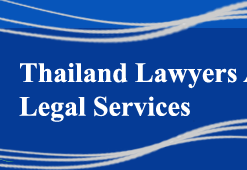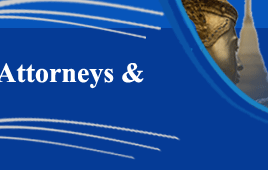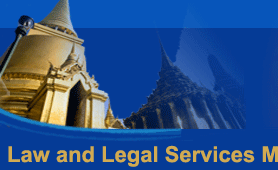



    |
|
| |
|
Money Laundering
Written
for the ICC’s Standing Committee on Extortion and Bribery
“Corporate Practices Manual on Extortion and Bribery”
by
David
Lyman, Senior Partner
Tilleke & Gibbins
Rev. February 17, 1999
Why does a Manual on Corporate Practices for businesses devote a chapter to “Money Laundering”?
Other chapters of this Manual deal with extortion and bribery and how to curtail corruption in public-private and private-private transactions. This chapter addresses how the ill-gotten monies therefrom are disposed of, if not spent promptly. It is called "money laundering". By common usage and statutory definition, money laundering is a crime. Perforce, an examination of money laundering extends beyond extortion and bribery into the realms of narcotics trafficking, frauds, tax evasion and other serious crimes, domestic and transnational.
Should the reader care? Yes. For openers, any business, whether a financial institution, professional service, industrial enterprise, charitable NGO or otherwise, caught in the web of money laundering could have its reputation irreparably damaged. Its directors, management and staff could be the subjects of private and public investigations out of which indictments and prosecutions could arise. At best, it would be a public relations nightmare. It only takes one unethical person who has the discretion to make decisions to jeopardize an entire organization. A reputation for integrity takes many years to build, and only a few moments to damage, debase, decimate or destroy.
Virtually all businesses would be wise to be alert to money laundering methods and tactics. For their own protection and preservation, businesses must build and implement defenses and countermeasures, and install various other forms of protection.
While anti-money laundering laws have been or are being adopted in over 100 countries around the world, no country yet requires its financial institutions to detect money laundering. Pragmatically, the most they can do is to require that “suspicious transactions” (hard to define) be reported, subject to a plethora of regulations and policies. Despite the pressing need, which is slowly being recognized by nation states, the effectiveness of anti-money laundering laws has been mixed, i.e. better than no laws at all, but falling far short of the ideal of strict, fair and universal enforcement with well-knit international cooperation within and between governments, regulatory and supervisory authorities, law enforcement agencies, the judiciary and ever the private sector. As usual, vigorous enforcement is limited to too few countries.
What exactly is money laundering?
The phrase is descriptive. In its simplest non-legal terms, money laundering is “the processing of criminal proceeds (profits or other benefits) in order to disguise their illegal origin” (FATF). Another definition is “the process of transforming the proceeds of illegal activities into legitimate capital” (Mr. Byung-Ki Lee—Korea Institute of Criminology). Note that the act of money laundering occurs only after a predicate criminal offense has been committed to generate the criminal proceeds which in turn need to be laundered to convert them into “legitimate capital”. This transition process has become a thriving business, albeit quite illegal in some, but not yet all, countries.
Note that if the money being moved did not come from an illegal activity, then its handling and processing are not considered money laundering. Thus, preparatory measures are not necessarily illegal within the money laundering context, e.g. pre-positioning funds to be used for, say, bribing a foreign government official.
Money laundering has three aspects. The first is physical disposal of the cash, i.e., its placement. The second is to disguise an audit trail to make the money, in effect, disappear. The technique is called layering, i.e., moving the money around, through and to multiple institutions in different jurisdictions. The adoption of the Euro as a common currency in Europe simplifies the flow of funds obviating the complications of shifting between multiple currencies. The final step is to bring the money back into the mainstream of commerce and investment as legitimate funds--it is called integration.
How pervasive is money laundering?
Money laundering is said to be the world’s third largest business by value! And it is growing. How big is it? No one knows with any degree of certainty. Both experts and competent authorities avoid estimating the scope. That sidestepping does not help the reader. Let us say evidence points to an answer of hundreds of billions of US dollars per annum. In early 1995, the OECD, headquartered in Paris, estimated the scale of laundering of drug money alone, excluding proceeds of other crimes and tax evasion, to exceed US$ 1,100 billion annually. The Financial Times of London estimated this trade value at only US$ 500 billion annually, which sum, nevertheless, amounts to 2% of global GDP!
In the FT Fraud Report of October 1997, it was reported that "The Black Economy in the UK is generally estimated by informed sources to amount to approximately 7% of GDP. In the USA, it is estimated at approximately 9% of GDP; in Germany, the figure approximates to 10%, while Italy, Greece and Spain are believed to have black economies amounting to approximately 25% of their GDPs. In Russia and Central and Eastern Europe, it is anticipated that the black economy could amount to as much as 50% of GDP." Asia, Africa, the Middle East and Latin America have their own substantial black economies.
Fraud often generates money laundering. Businesses are subject to fraud through simple and complex deceptions by both insiders--employees, agents--and by outsiders. Being a fraud victim is embarrassing and expensive and recoveries are limited. On a more widespread scale, of the information age, fraud can occur through credit cards, smart cards, stored value cards, e-money, e-commerce, etc. Technology helps both the good and the evil.
Incidentally, illustrative of how pervasive narcotics have become in our society, it is said that 90% of the currency bills in circulation in the USA are contaminated with narcotics. In the UK, the amount is considered as being 40%.
These estimates dwarf the US$ 11.7 billion anticipated to be gained in the global trade of counterfeit computer software (BSA and SPA) in 1998. The ICC-Paris in 1996 estimated that 5-8% of total world trade, say US$ 250 billion, is in counterfeit products of all types. Much of the monetary proceeds thereof pass through money laundering schemes.
From what crimes does money laundering arise—i.e. sources of illegal proceeds?
The term money laundering is of relatively recent origin. In their modern context, anti-money laundering precepts and laws were originally only aimed at the disposing of the proceeds of the trade in narcotics, inclusive of psychotropic substances. Though hiding money has been around probably since currency was invented, the US, in 1986, was the first country in the world to criminalize money laundering but only as it related to the illegal drug trade. It was soon realized by the US and other countries that the ill-gotten proceeds of extortion, bribery and fraud also needed international cooperation legislation to inhibit money laundering, to track and recover the illegal money, and to prosecute offenders. With the onset of globalization, instantaneous electronic money transfers, the growth in the last decade of organized crime and the public disclosure of scandals, public-private and private-private corruption, and other serious crimes involving money laundering practices, unfortunately, have been blossoming.
Besides narcotics production and trafficking, and depending upon the selection by each country of which serious crimes to include in their own national anti-money laundering enactments, there is a vast array of nefarious activities which generate questionable profits and which are or could be addressed in anti-money laundering legislation. Examples are extortion, bribes, protection rackets, terrorism, smuggling of goods (favorites are alcohol, cigarettes, computer chips and raw materials), smuggling of weapons, nuclear material, precious metals and precious gems (primary diamonds) to avoid customs; illegal immigration and smuggling of people to avoid immigration, white slavery and trafficking in women for prostitution, pedophile activities; intellectual property (trademarks, copyrights, patents, trade secrets and know-how); theft and resale of commodities, metals, oil, gas, art, antiques and historical artifacts; counterfeiting (currency and documents); crimes of violence (contract killing, arson and bombing); illegal logging (particularly tropical forests), trade in endangered species of animals and plants, and even in human body parts; environmental crimes (solid, toxic and hazardous waste disposal; air, water, noise pollution; unsustainable development); usury; investment and VAT fraud, false invoicing and financial fraud (bank fraud, credit card fraud, investment fraud, advance fee fraud, bankruptcy fraud, embezzlement, misappropriation, insurance fraud, passports, visas and documentation); motor car thefts, tax fraud, tax evasion; illegal gambling; maritime crimes (piracy, charter party frauds, cargo deviations, phantom ships, marine theft, marine pollution); technology crimes; theft over the Internet, Internet crime generally. While lengthy, this list is neither exhaustive nor all-inclusive.
Though the above list is extensive, it bears repeating that each individual country specifies in statutes those serious crimes which are to be subject to its money laundering laws. They may be few, or they may be many. The more crimes covered, the more difficult money laundering should become. Check the laws of those jurisdictions in which you do business and banking.
Have there been international endeavors to promote anti-money laundering acceptance?
Anti-money laundering laws, policies and practices are only recently gaining broad acceptance among nation states and regional and international organizations. In 1989, the G-7 countries created the Financial Action Task Force (“FATF”), an independent intergovernmental agency comprising 26 countries including the principal major economies, and two regional organizations. The purpose of this organization is to examine and report on measures to combat money laundering, to monitor implementations of counter money laundering measures, to track and review money laundering activities, and to promote FATF activities and advise members and non-member countries. Its headquarters are located within the OECD in Paris, France.
In 1990, the FATF issued its Forty Recommendations which “provide a comprehensive blueprint for action against money laundering, covering the criminal justice system and law enforcement, the financial system and its regulation; and international cooperation” (FATF). Amended in 1996 to reflect changes in money laundering trends and potential future threats, the Forty Recommendations are the most comprehensive set of anti-money laundering directives yet created for governments, legislatures, law enforcement, financial institutions and businesses in general.
Other international and regional bodies have issued or adopted similar guidelines, in whole or in part, namely, the United Nations and several of its specialized agencies, the International Organization of Securities Commissions, the European Union (EU), the Council of Europe, Gulf Cooperation Council, Organization of American States (OAS), Caribbean Financial Action Task Force (CFATF), South Pacific Forum, Asia/Pacific Group on Money Laundering, Council for Security Cooperation in the Asia-Pacific (CSCAP), INTERPOL, ASEANPOL, World Customs Organization (WCO), Southern and Eastern Africa Financial Action Task Force (SEAFATF), Bank for International Settlements (BIS), Basel Committee on Banking Supervision, International Banking Security Association, Banking Federation of the European Union, Organization for Economic Cooperation and Development (OECD), among others. In other words, with the concepts of good governance, transparency and accountability being adopted into the work-a-day realms of the public and private sectors, as demanded by civil society, anti-money laundering policies and practices are finally gaining the attention of governments and international organizations throughout the world.
The bribery of foreign public officials to obtain or maintain business was criminalized first in 1997 in the US embodied in the now famous "Foreign Corrupt Practices Act". Twenty years later, the OECD issued its "Convention on Combating Bribery of Foreign Public Officials in International Business Transactions". In late 1998, this Convention came into force, having been ratified by the required number of signing countries. Article 7 thereof criminalizes the money laundering aspect of the predicate offense of bribery. Article 7, therefore, if enforced, is a key hope in stemming this type of corruption.
What are some of the techniques used by money launderers?
The FAFT annual reports and reports on money laundering typologies are some of the best sources of information on the subject. (See the FAFT website at “www.oecd.org/faft/reports.html”.) The aforementioned Forty Recommendations can also be downloaded from this site. Another source of current information on money laundering is “Money Laundering Alerts” by Alert Global Media, a subscription service, which is available at “www.moneylaundering.com”. Alert Global Media’s list of “Suspicious Activities” examples is instructive and illuminating.
The techniques of money laundering can be broken down into three principal categories: (A) banking, (B) non-bank institutions, and (C) non-financial businesses. In bullet point form for brevity, the methods are summarized as:
A. Banking
B. Non-Bank Financial Institutions
C. Non-Financial Businesses or Professions
For more detailed descriptions of the techniques and how they have worked, actual case studies can be found in the “Money Laundering Guide” published in mid-1998 by the Commercial Crime Bureau of the ICC located in Barking, England, UK. (See their website at: “www.iccwbo.org/icccbhp.htm”. See also Billy's Money Laundering Information website at "www.laundryman.u-net.com". Another interesting site is the Financial Crimes Enforcement Network at "http://www.ustreas.gov/fincen.")
Anti-Money Laundering Institutions - Deterrence and Countermeasures
There are several concepts of deterrence which have recently garnered broad support. Businesses should consider working them into their own normal accounting and financial control systems. Money laundering can occur innocently as well as deliberately.
The first step is to access your own risk profile and vulnerability to being used for money laundering—check your internal control systems, policies and operations. Establish internal anti-money laundering policies and procedures and put senior people in charge of compliance and staff training.
The fundamental theme common to most of the countermeasure initiatives is the old maxim of “Know Your Customer” and “Know the Counter Partners”—identify and verify them through third party due diligence. And maintain files on them. Know who you are dealing with at both ends of a transaction.
“Know Your Business” is another vital concept. Protect your integrity and reputation. Know how, when and where to recognize unusual transactions.
“Know your Administration”—accurate and complete record-keeping and reporting compliance is crucial to keep your own business and the anti-money laundering system functioning. Create audit trails. Audit to test and track your own anti-money laundering compliance systems.
Recognize suspicious transactions and transaction sizes and report them to internal compliance officers and the competent authorities in accordance with anti-money laundering regulations, laws and policies. Check the suspicious indicators lists for guidelines.
Educate, train and periodically test employees to create and maintain their awareness.
Be forewarned that it is not just corporate reputations which are at risk for allowing money laundering to occur, but officers, directors and other individuals involved can face prison terms, substantial fines, and unusual confiscations. One unscrupulous renegade in an organization can taint all the honest people in that organization. The costs of reputation repair and recovery are enormous, far outweighing the costs of precaution.
Conclusions
Money laundering is BIG business. Should your business inadvertently, directly or even indirectly, become a victim of or a participant in any serious crime, the chances are high that your money will disappear through one or more money laundering ploys. Finding your money and recovering it will be time consuming and expensive, and for some, most embarrassing. Probably less than 10% of the victims, corporate and individual, take the effort to even attempt recovery of lost funds.
Protect yourself and your integrity with the “Know Your…” concepts. Anti-money laundering laws have yet to prove their effectiveness, and international cooperation between governments with respect to money laundering is only now being established. Such laws, practices and cooperation have to work if legitimate business is to survive and prosper.
Finally, for readers who want to learn more about money laundering, please refer to lists of Internet links on the Web at: “http://macau.ctm.net/jgod/m/html” and “http://www.ex.ac.uk/RDavies/arian/scandals/launder/html”. Also periodically check the website of Transparency International, the coalition against corruption in international business at "http://www.transparency.de".